◄ Carnets Geol. 14 (22) ►
Contents
[I - Introduction]
[II - Geological setting]
[III - Material and methods]
[IV - Discussion] [V - Conclusions] and ... [Bibliographic references]
Department of Ecology and Evolutionary Biology, The University of Kansas, 1200 Sunnyside Avenue, Lawrence, Kansas 66045 (USA)
GEGENAA EA 3795, University of Reims Champagne-Ardenne, CREA,
2 esplanade Roland Garros, 51100 Reims (France)
Département de Géologie et de Paléontologie, Sciences de la Terre et de l'Environnement,
13 rue des Maraîchers, 1211 Genève 4 (Switzerland)
Published online in final form (pdf) on December 24, 2014
[Editor: Christian C. ; technical editor: Bruno ;
language editor: Phil ]
In the Canton of Vaud (Switzerland), two Hauterivian oolitic units were penetrated by a borehole. In both units, the ooids are partly leached. More specifically, the ooid cortices were partly leached and some ooid nuclei appear suspended in the middle of cortical moldic cavities created by leaching, rather than having fallen to the bottom of these cavities before the final cementation take place. We demonstrate that these ooids were originally calcitic, not aragonitic, not "two-phase" nor "bimineral". This leaching is not an early diagenetic feature related to subaerial exposure, but a late diagenetic feature, possibly related to the migration of acidic pore waters, brought about by Alpine tectonics and/or karstification.
Switzerland; Urgonian; Hauterivian; calcareous ooids; dissolution; calcite, aragonite; organic matter.
B., V. &J. (2014).- Significance of partial leaching in calcareous ooids: The case study of Hauterivian oolites in Switzerland.- Carnets de Géologie [Notebooks on Geology], Brest, vol. 14, nº 22, p. 471-481.
De l'importance des dissolutions partielles dans des ooïdes calcaires : Exemple des oolithes hauteriviennes de Suisse.- Dans le Canton de Vaud (Suisse), deux unités oolithiques hauteriviennes ont été traversées par un forage. Dans ces deux unités, les ooïdes sont partiellement dissouts. Plus précisément, les cortex oolithiques ont été partiellement dissouts et quelques nuclei oolithiques semblent suspendus au milieu de cavités moldiques créées par la dissolution de ces cortex, au lieu d'être tombés sur le fond de ces mêmes cavités avant que la phase finale de cimentation ait eu lieu. Nous démontrons que ces ooïdes étaient originellement calcitiques et non aragonitiques, non composés des deux polymorphes du carbonate de calcium et encore moins de deux minéraux distincts. Cette dissolution n'est pas un phénomène diagénétique précoce lié à une émersion, mais un phénomène diagénétique tardif qui pourrait bien être lié à la circulation d'eaux souterraines acides favorisée par des réseaux de fractures (en liaison avec la structuration des Alpes) ou de conduits karstiques.
Suisse ; Urgonien ; Hauterivien ; ooïdes calcaires ; dissolution ; calcite ; aragonite ; matière organique.
Calcareous ooids are coated grains of diverse size, shape, fabric and mineralogy (calcite and aragonite), which form one of the most fascinating category for people studying carbonate rocks. Among the special fabrics, ooids with partly replaced or dissolved cortices are commonly interpreted as "two-phase" or "bimineralic" (, 1984; & , 1994; & , 1995; & , 1995). The radial-fibrous fabric of some cortical layers is considered to be primary and their original mineralogy is commonly high-Mg calcite in marine environments. In the case of a replacement, the original structures are "often obliterated and at best represented only by faint relics" (, 1984); this fabric is interpreted as reflecting an original aragonitic mineralogy. Similarly, in the case of dissolution (followed or not by drusy calcite cementation), the original mineralogy of these leached layers is commonly interpreted as aragonite (e.g., et al., 1983). However, in this case study, it is demonstrated that leaching has affected cortical layers with a radial-fibrous fabric and that this diagenetic pattern was not related to an original aragonitic mineralogy. Furthermore, this case demonstrates that the presence of "shrunken", "half moon" or "collapsed" ooids may not necessarily be indicative of early subaerial exposure and subsequent freshwater leaching to create secondary porosity as is commonly thought (e.g., et al., 1983). In short, calcareous ooids can provide useful information in terms of the environment of deposition and diagenesis (, 1986; , 2001, inter alia). The purpose of this study is to describe the petrography of distinctive ooids with partly dissolved cortices and to offer an explanation for their origin.
The case studied is documented by material from a drill-hole core near Montricher
(Fig. 1 ![]() ), a Swiss locality not far from Éclépens (less than 20 km to the east), which is better known for the controversial bio- and sequence stratigraphies of its Lower Cretaceous (Urgonian) section (see discussions in et al.,
2012; et al.,
2013; et al.,
2014). The same features can be observed in the oolitic intervals of both localities.
), a Swiss locality not far from Éclépens (less than 20 km to the east), which is better known for the controversial bio- and sequence stratigraphies of its Lower Cretaceous (Urgonian) section (see discussions in et al.,
2012; et al.,
2013; et al.,
2014). The same features can be observed in the oolitic intervals of both localities.

Click on thumbnail to enlarge the image.
Figure 1: Location map of Montricher (geographic coordinates x:520,025 y:162,180 altitude 665 m, 46°36'11.8"N 6°23'57.9"E; Google coordinates: 46.603478, 6.399386) and Éclépens (Holcim quarry, geographic coordinates x:531,256 y:167,183, 46°39'12.6"N 6°32'40.3"E; Google coordinates: 46.653485, 6.544517), Canton of Vaud, Switzerland.
The Morand drill hole was initially bored in 1968 to help characterize the hydrogeological conditions and later geothermal setting of the Municipality of Montricher, District of Morges, Canton of Vaud, Switzerland. After cutting nearly 37 metres of Quaternary sediments it penetrated Lower Cretaceous strata and ended in uppermost Jurassic rocks at a depth of nearly 388 metres (,
1969, unpublished; & ,
1993; et al., 2003; et al.,
2014). It was fully cored and the remaining core material is currently stored in the "Musée cantonal de Géologie" of Lausanne, Switzerland. Regarding its lithostratigraphic subdivision
(Fig. 2 ![]() ), as in a previous paper describing the palaeophycological assemblages of the Lower Cretaceous ( et al.,
2014), the regional lithostratigraphic classification proposed by et al.
(2008) is adopted [in parallel we use the most recent lithostratigraphic classification of the Comité Suisse de Stratigraphie
(2014)]. However with respect to the topic of interest, the focus here is on the first 200 metres of the section that spans from top to bottom:
), as in a previous paper describing the palaeophycological assemblages of the Lower Cretaceous ( et al.,
2014), the regional lithostratigraphic classification proposed by et al.
(2008) is adopted [in parallel we use the most recent lithostratigraphic classification of the Comité Suisse de Stratigraphie
(2014)]. However with respect to the topic of interest, the focus here is on the first 200 metres of the section that spans from top to bottom:
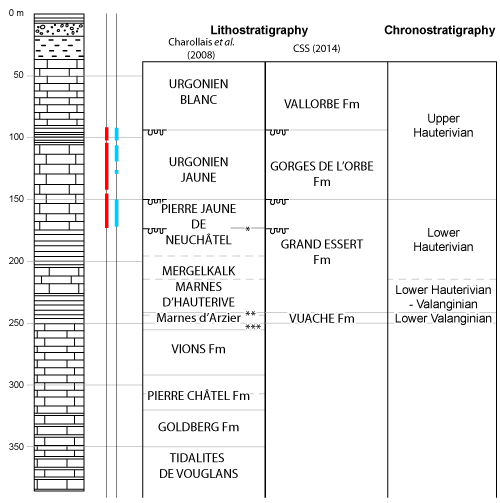
Click on thumbnail to enlarge the image.
Figure 2: Stratigraphic column of the Morand drill hole with the location of the bored hardgrounds and occurrences of the Hauterivian ooids (in red), including those with partly dissolved cortices (in blue). Lithostratigraphic log of the Morand drilling (redrawn and modified from et al., 2003, p. 130). Caption: *: "Marnes d'Uttins", **: "Calcaires roux", ***: Chambotte Fm.
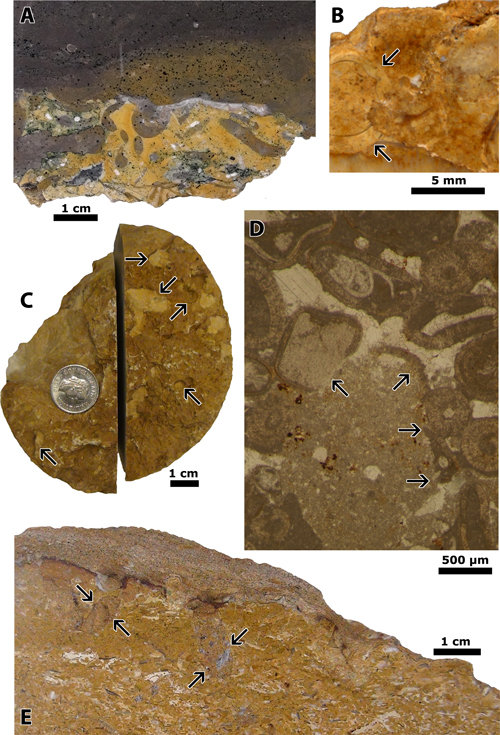
Click on thumbnail to enlarge the image.
Figure 3: A: 172.45 m (scale bar: 1 cm) slab with the bored hardground at the lower-upper "Pierre jaune" boundary; B: 92.42 m (scale bar: 5 mm) slab with the bored hardground at the "Urgonien jaune" - "Urgonien blanc" boundary; C: 92.42 m (scale bar: 1 cm) transverse view of a core documenting the bored hardground at the "Urgonien jaune" - "Urgonien blanc" boundary; D: sample 122 m (scale bar: 500 µm) thin-section documenting a boring in a small oolitic lithoclast in the "Urgonien jaune"; E: sample 149.30 m (scale bar: 1 cm) slab with the bored hardground at the "Pierre jaune" - "Urgonien jaune" boundary.
People working in the same Swiss Jura area, mostly PhD students (, 1995; , 2005; et al., 2005; , 2006), had already reported the occurrence of ooids with partly dissolved cortices (, 2005: p. 73, Pl. 36; et al., 2005: p. 85, Pl. 41.e; , 2006: p. 47, Fig. B.9/E), both in "Urgonien jaune" and "Pierre jaune" units. Apart from the highly speculative assumptions of (1995: p. 107. See the excerpt), these features were interpreted as evidence for subaerial exposure and as a reliable criterion to identify sequence boundaries above these intervals.
With a sample spacing of one per metre over the 37-388 metre interval, some 350 standard petrographic thin-sections cover the whole cored section. Nearly 70 thin-sections can be referred to
oolites
(Fig. 2 ![]() ,
in red), dominantly oolitic grainstones, with some oolitic wackestones and mixed bioclastic-oolitic facies; ooid cortices are partly leached in more than half of
them
(Fig. 2
,
in red), dominantly oolitic grainstones, with some oolitic wackestones and mixed bioclastic-oolitic facies; ooid cortices are partly leached in more than half of
them
(Fig. 2 ![]() ,
in blue). In the upper "Pierre jaune" auct., the ratio is even higher; for instance, dissolution affected the ooids over more than 15 successive thin-sections, i.e., over a continuous oolitic sequence more than 14 metres thick.
,
in blue). In the upper "Pierre jaune" auct., the ratio is even higher; for instance, dissolution affected the ooids over more than 15 successive thin-sections, i.e., over a continuous oolitic sequence more than 14 metres thick.
Uncovered polished thin-sections from the samples were examined under a cold-cathode luminescence instrument from OPEA (Laboratoire d'Optique Électronique Appliquée, Vincennes, France) mounted on a petrographic microscope (Olympus, BX-50). The electron beam is obtained from a metal blade to reach a negative electrical potential relative to the support of the sample. A cold cathode source electron gun was chosen for its ability to produce a stable electron beam (intensity-current fluctuations < 1%). Observations were carried out at an accelerating voltage of 17-20 keV and an operating current of 250-400 mA. Images were collected with a QUICAM Imaging Fast1394 digital camera in time-integration mode using the Archimed Pro Microvision. Good quality photomicrographs were obtained by the stacking of single images.
Seven oolitic samples were selected from the upper "Pierre jaune" (152, 154, 160.25, 166, 167, 168, and 170 m) for cathodoluminescence imagery.
In the grainy oolitic facies the calcitic cement in place of the former primary porosity is typically drusy, with crystals increasing in sizes toward the centre of the inter- or intragranular space. Former aragonitic skeletal grains are represented by micrite envelopes filled by the same drusy cement (Fig. 4.I ![]() ). Some echinoderm fragments develop the classic syntaxial cement, locally in the form of large poikilotopic crystals; others have a microbial coat and did not develop any overgrowth. In places a thin fringe of fibrous, probably high-Mg calcite cement (Fig. 6.A, 6.C
). Some echinoderm fragments develop the classic syntaxial cement, locally in the form of large poikilotopic crystals; others have a microbial coat and did not develop any overgrowth. In places a thin fringe of fibrous, probably high-Mg calcite cement (Fig. 6.A, 6.C ![]() ) preceeds the drusy, probably low-Mg calcite cement. Finally, the cement filling the remaining secondary porosity, partly dissolved ooid cortices or open fractures (thin breaks as in
Fig. 6.C
) preceeds the drusy, probably low-Mg calcite cement. Finally, the cement filling the remaining secondary porosity, partly dissolved ooid cortices or open fractures (thin breaks as in
Fig. 6.C ![]() or larger fractures Figs. 4.H
or larger fractures Figs. 4.H ![]() , 5.A-B
, 5.A-B ![]() ), is also drusy but it differs from the previous type in that it looks more transluscent (Figs. 4
), is also drusy but it differs from the previous type in that it looks more transluscent (Figs. 4 ![]() ,
6.A, 6.C
,
6.A, 6.C ![]() ); in addition, it is more blocky, possibly because there were fewer active nucleation sites to promote crystal precipitation on the walls of the moldic cavity. There are several families of fractures
(Fig. 5.A
); in addition, it is more blocky, possibly because there were fewer active nucleation sites to promote crystal precipitation on the walls of the moldic cavity. There are several families of fractures
(Fig. 5.A ![]() ); some fractures
(Fig. 5.B
); some fractures
(Fig. 5.B ![]() ) might be cemented by large (?) dolomite crystals [note: this identification is uncertain since thin-sections were not stained].
) might be cemented by large (?) dolomite crystals [note: this identification is uncertain since thin-sections were not stained].
Since ooid cortices show various stages of dissolution, earlier studies (, 1995; , 2005; et al., 2005; , 2006) concluded that these features are related to an early diagenetic event associated with subaerial exposure at a sequence boundary. However, the difference observed in the transparency and the blockiness of the two types of drusy cement suggests it might not be as simple as it first seemed.
Since these ooid cortices mostly consist of an outer drusy calcitic part (cement) and an inner fibro-radial part (almost unaltered), one might have also assumed that these ooids were
"two-phase" or "bimineralic" ooids with an outer primarily aragonite cortical part and an inner primarily calcite cortical part. However, some radial-fibrous cortical layers are interrupted obliquely by the dissolution front (Figs. 4.A, 4.F ![]() ,
6.A
,
6.A ![]() ), a fact that contradicts the previous interpretation.
), a fact that contradicts the previous interpretation.
In addition, many ooid nuclei remained in the same position that they occupied before dissolution take place. These 'suspended' nuclei (Fig. 4.A, 4.E, 4.G ![]() ) appear to float in a "blocky" drusy sparite, rather than falling to the bottom of the cortical moldic cavity. The leaching was probably incomplete and with something, either organic (the most likely) or mineral or a combination of the two, maintaining the nuclei in its original position before its peripheral cementation.
) appear to float in a "blocky" drusy sparite, rather than falling to the bottom of the cortical moldic cavity. The leaching was probably incomplete and with something, either organic (the most likely) or mineral or a combination of the two, maintaining the nuclei in its original position before its peripheral cementation.
In conclusion, since the well-preserved radial-fibrous fabric is characteristic of primarily calcite ooids, and because within the same cortex some layers are both partly leached and partly preserved, it can be assumed that these ooids were primarily high-Mg calcite, not two-phase (aragonite and calcite).
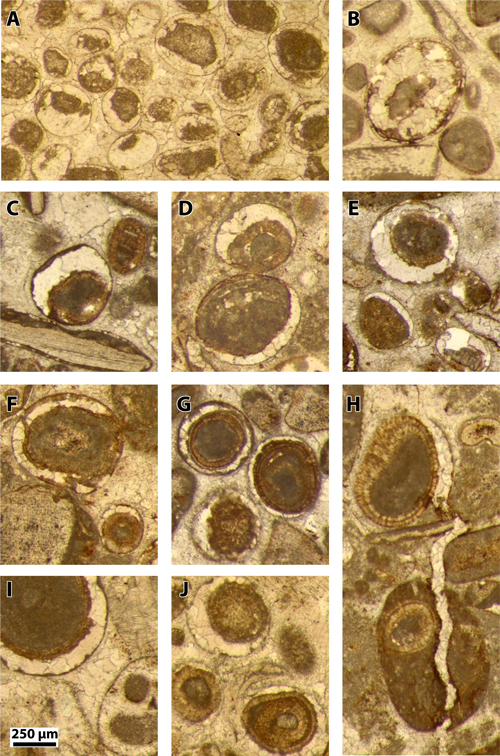
Click on thumbnail to enlarge the image.
Figure 4: A-B: "Urgonien jaune"; C-J: "Pierre jaune de Neuchâtel". A : 94 m, partly leached cortices; B: 112 m, partly leached ooid; C: 166 m, partly leached ooid; D-F: 167 m, partly leached cortices with a 'suspended' nucleus in E; G-H: 168 m, G: partly leached cortices; H: fracture with rather transluscent cement; I-J: 170 m, I: the cement in the former intergranular or biomouldic porosity is less translucent than that in the former oomouldic porosity; J: partly leached cortices [All photomicrographs same scale bar 250 µm].
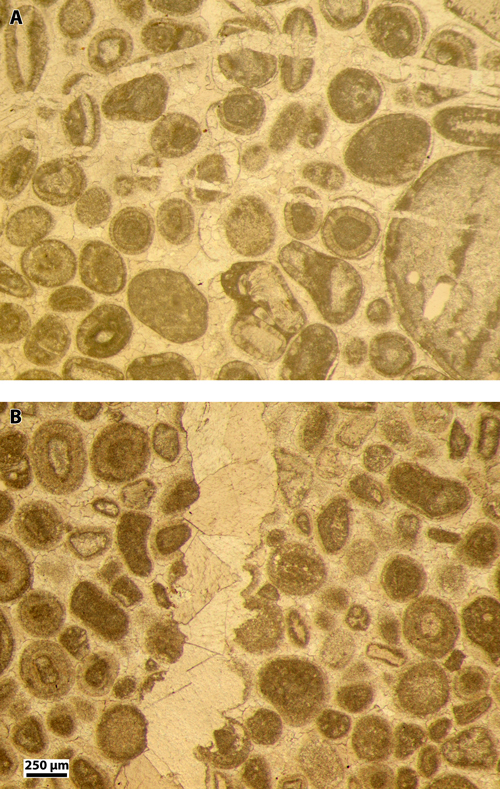
Click on thumbnail to enlarge the image.
Figure 5: A-B: "Urgonien jaune". A: 93 m, two families of fracture, the subhorizontal ones are cutting the vertical one; B : 109 m, a fracture cemented by large (?) dolomite crystals [All photomicrographs same scale bar 250 µm].
Cathodoluminescence is widely used in all aspects of petrographic studies ( et al., 2000; & , 2010, inter alia). Cathodoluminescence imaging is particularly used to identify porosity loss or to distinguish different cement generations (see case studies in: , 1994; & , 2009, inter alia).
The fibrous cement fringe, inferred to have been the result of early marine cementation, is non-luminescent calcite, probably high-Mg calcite. It is also the case with the proximal (early) phases of crystal-growth in the syntaxial cement on the echinoderm grains and in the dull crystals of the intergranular drusy cement. There a black-dark brown zone is commonly followed by a reddish brown-orange alternation and then by a final yellow stage
(Fig. 6.F ![]() ). These zones are also present in the former aragonitic skeletal grains, but the cement filling partly dissolved ooid cortices luminesces in discrete orange-chocolate brown tones (Fig. 6.B, 6.C, 6.E, 6.G
). These zones are also present in the former aragonitic skeletal grains, but the cement filling partly dissolved ooid cortices luminesces in discrete orange-chocolate brown tones (Fig. 6.B, 6.C, 6.E, 6.G ![]() ), contrasting with the previous shades of colour [Remark: the tones might vary from one picture to another, depending on the photo session or later digital alteration]. These tones are not part of the sequence: they clearly post-date it. In conclusion, the dissolution of the ooid cortices preceeded their future cementation, but it followed an earlier burial cementation stage. These observations support the earlier conclusion that the dissolution of the ooid cortices and their cementation are late diagenetic events, not early ones.
), contrasting with the previous shades of colour [Remark: the tones might vary from one picture to another, depending on the photo session or later digital alteration]. These tones are not part of the sequence: they clearly post-date it. In conclusion, the dissolution of the ooid cortices preceeded their future cementation, but it followed an earlier burial cementation stage. These observations support the earlier conclusion that the dissolution of the ooid cortices and their cementation are late diagenetic events, not early ones.
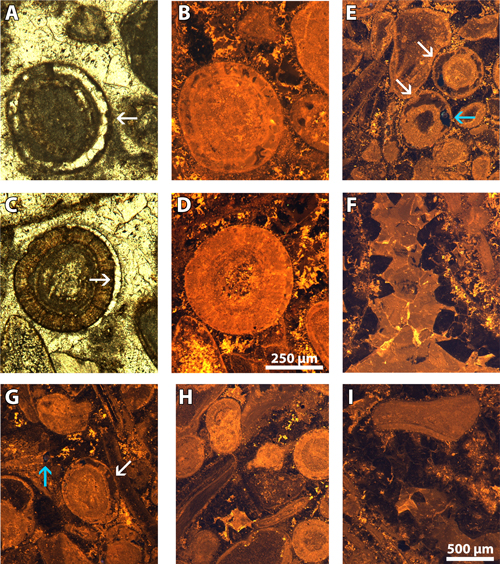
Click on thumbnail to enlarge the image.
Figure 6: A-I: "Pierre jaune de Neuchâtel". A-D and F: 168 m. A-B: partial leaching of the outer cortical layers (A: conventional transmitted light; B: cathodoluminescence); C-D: break/tiny fracture at the outer surface of an ooid, between the ooid cortex and the early cement. Such a break can be compared with those observed along the vertical fracture on Fig. 5.A (C: conventional transmitted light; D: cathodoluminescence); E and G: 167m. E: white arrows for the chocolate brown cement filling the partly dissolved cortex and blue arrow for an hole -with air bubble- in the thin-section preparation (cathodoluminescence). F: cementation of a large (?) bioclast porosity by the successive early black-dark brown, median reddish brown-orange, and late yellow stages (cathodoluminescence). G: white arrow for the chocolate brown cement filling the partly dissolved cortex and blue arrow for a hole -with air bubble- in the thin-section preparation (cathodoluminescence). H: 166 m, cementation of intergranular porosity by early black-dark brown and median reddish brown-orange stages (cathodoluminescence). I: 170 m, cementation of intergranular porosity mostly by the early black-dark brown stage (cathodoluminescence) [A-D scale bar 250 µm; E-I scale bar 500 µm].
How could dissolution have occurred? The most probable scenario is to consider that acidic waters seeped into the cemented oolitic rocks, probably through a fracture network, possibly tectonic, or karstic, during the Alpine orogeny. Later, the brines circulating in the open fractures favoured their subsequent cementation and that of the dissolved ooid cortices by a "blocky" drusy sparite or (?) dolosparite.
Why were only the ooid cortices leached? Leaching did not affect the micritic mud, other calcareous grains, micrite envelopes, the ooid nuclei nor the sparitic cement; only ooid cortices are partly or fully dissolved. The dual nature, mineral and organic, of the ooid cortices (see , 1936; , 1967, 1968; , 1968; , 1995, 2014, inter alia, and for examples of experimental ooids see , 1957a, 1957b; et al., 2004, inter alia) is probably a key to understand this selective dissolution. A late oxidation of the organic matter within the ooid cortices is possibly responsible for a microporosity, which could have favoured the dissolution of the tiny radial-fibrous crystals by an increase of their contact surface with acidic waters. It is noteworthy in this context that the dissolution is always centripetal, the innermost cortical layers remain unaltered in some cases. Several hypotheses can be considered, but no firm conclusions can be made. For example: 1) the ratio of mineral to organic material or 2) the degree of oxidation of the organic matter might have varied from the inner to the outer cortical layers, or 3) the centripetal oxidation process was interrupted due to the lack of sufficient time.
In both of the Hauterivian oolitic units studied, many ooid cortices were partly leached and the ooid nuclei commonly appear to float in the middle of the resulting mouldic cavities. However, as highlighted by (2014): "the statement that aragonitic ooids are commonly dissolved does not imply the converse, i.e., that dissolved ooids were originally aragonitic". Actually the remaining radial-fibrous fabric of the ooid cortices suggest that these calcareous ooids were originally calcitic, not aragonitic, not "bimineralic", nor "two-phase". The organic material present in the ooid cortices is probably a key factor to explain features such as the incomplete cortical leaching and 'suspended' nuclei. Since the dissolution and the subsequent "blocky" drusy cementation postdate the intergranular drusy cementation (there are two discrete drusy phases), both phenomena are considered to be late diagenetic events. Dissolution is probably related to tectonics and/or karstification that favoured the seepage of acidic waters. As documented herein and contrary to previous assertions, ooid leaching is not necessarily an early diagenetic feature affecting aragonitic or "two-phase" ooids in relation to subaerial exposure.
Special thanks are due to Gilles and Robin of the "Musée cantonal de Géologie" of Lausanne for having facilitated our access to the studied core material stored on their premices, to Mark for his appreciated help, as well as to Gaëlle for sharing information on her unpublished material (, 2007). The Foundation "Carnets de Géologie" provided financial support to two of us (B.G., J.C.) for our missions to Lausanne in November 2013 and August 2014. We also thank the reviewers, Maurice and André , for their constructive comments, as well as Maurice and Phil for their assistance in revising the English text.
T.J. & B.A. (1995).- Calcite, aragonite, and bimineralic ooids in Missourian (Upper Pennsylvanian) strata of Kansas: stratigraphic and geographic patterns of variation. In: P.H. & M.P. (eds.), Carbonate facies and sequence stratigraphy: practical applications of carbonate models.- Society of Economic paleontologists and Mineralogists, Publication, Tulsa, vol. 95, nº 36, p. 141-173.
R.G.C. (1967).- Oölitic films on low energy carbonate and sand grains, Bimini Lagoon, Bahamas.- Marine Geology, Amsterdam, vol. 5, nº 2, p. 89-109.
R.G.C. (1968).- Precipitation of oöids and other aragonite fabrics in warm seas. In: G. & G.M. (eds.), Recent developments in carbonate sedimentology in central Europe.- Developments in Sedimentology, New York, p. 1-10.
M.-C. (1995).- Importance des discontinuités dans l'enregistrement sédimentaire de l'Urgonien jurassien. Micropaléontologie, sédimentologie, minéralogie et stratigraphie séquentielle.- Thesis, Université de Grenoble; Géologie Alpine, Mémoire HS, Grenoble, nº 24, 299 p. Online at https://tel.archives-ouvertes.fr/tel-00723728/document
S. & D. (2010).- Application of cathodoluminescence imaging to the study of sedimentary rocks.- Cambridge University Press, 165 p.
U., K.A. & W.E. (2004).- Laboratory cultures of calcifying biomicrospheres generate ooids - A contribution to the origin of oolites.- Carnets de Géologie [Notebooks on Geology], Maintenon, Letter 2004/03 (CG2004_L03), 6 p. (1 video).
E. (2005).- Diagenesis in carbonate rocks: relations with sequence boundaries in a sequence stratigraphic framework. In: T., A., H., M.-C., S., E., K.B., A., M.C. & J. (eds.), The Hauterivian-Lower Aptian sequence stratigraphy from Jura platform to Vocontian basin: a multidisciplinary approach.- Géologie alpine, Grenoble, (série spéciale "Colloques et Excursions"), nº 7, p. 69-77. Online at https://hal-insu.archives-ouvertes.fr/insu-00723810/document
B., J., M.A., du R., R., S., E., R., A., D., B., J. & M. (2007).- Dating and progradation of the Urgonian limestone from the Swiss Jura to South East France.- Zeitschrift der Deutschen Gesellschaft für Geowissenschaften (ZdGG), Darmstadt, Band 158, Heft 4, p. 1025-1063.
J., B. & R. (2008).- Biostratigraphie et découpage séquentiel des formations du Crétacé Inférieur de la plateforme Jurassienne (France, Suisse). In : A Terra. O Conflitos e Ordem. Homenagem ao Professor Ferreira .- Museu Mineralógico e Geológico da Universidade de Coimbra, p. 197-207.
J., B., B., R. & M.A. (2013).- Discussion of the paper by et al. 2011, entitled "Reconciling strontium-isotope and K-Ar ages with biostratigraphy: the case of the Urgonian platform, Early Cretaceous of the Jura Mountains, Western Switzerland" (Swiss Journal of Geosciences, 104, 147-160).- Swiss Journal of Geosciences, Basel, vol. 106, nº 3, p. 559-567.
N. & N.P. (1995).- Facies-specific, calcitic and bimineralic ooids from Middle and Upper Cambrian platform carbonates, western Newfoundland, Canada.- Journal of Sedimentary Petrology, Tulsa, vol. 47, nº 5, p. 907-921.
Comité Suisse de Stratigraphie (2014).- Jura. In : Lexique lithostratigraphique de la Suisse.- swisstopo, Service géologique national. Online at http://www.strati.ch/index.php/fr/cms/downloads
M., B., B., J., R., E., S., du R., D., A., R., J. & M. (2012).- "Stratigraphic, sedimentological and palaeoenvironmental constraints on the rise of the Urgonian platform in the western Swiss Jura", by A. et al., Sedimentology (2010) 57, 1088-1125: Discussion.- Sedimentology, Oxford, vol. 59, nº 3, p. 1121-1125.
L. (1936).- Étude des calcaires par coloration et décalcification. Application à l'étude des calcaires oolithiques.- Bulletin de la Société géologique de France, Paris, (5ème série), t. VI, p. 237-244 (Pl. XVI).
A. (2006).- The evolution of the Urgonian platform in the western Swiss Jura realm and its interactions with palaeoclimatic and palaeoceanographic change along the Northern Tethyan Margin (Hauterivian-earliest Aptian).- PhD Thesis, Université de Neuchâtel, 405 p.
A., M.-C., S., T. & K.B. (2005).- Day 1. The Hauterivian - Barremian of the western Swiss Jura around Neuchâtel. In: T., - A., H., M.-C., S., E., K.B., A., M.C. & J. (eds.), The Hauterivian-Lower Aptian sequence stratigraphy from Jura platform to Vocontian basin: a multidisciplinary approach.- Géologie alpine, Grenoble, (série spéciale "Colloques et Excursions"), nº 7, p. 79-96.
B. (1994).- Datation de la poronécrose des réservoirs et de la mise en plce des hydrocarbures dans l'Oolithe du Callovien inférieur de Villeperdue (Bassin de Paris).- Nouvelles Géologiques, Total E.P., Paris La Défense, nº 17, p. 102-112.
B. (1995).- Bored oolites and biased hypotheses on the original mineralogy of some ancient ooids.- 6th International Symposium on Fossil Algae and Carbonate Platforms, Ankara, September 18th-22nd, 1 p. (abstract).
B. (2014).- Borings and etchings in the Upper Bathonian-Lower Callovian oolite of the Paris Basin (France).- Carnets de Géologie [Notebooks on Geoloy], Brest, vol. 14, nº 21, p. 461-469.
B., B., J. & M. (2014).- Latest Jurassic - Early Cretaceous Dasycladalean algae (Chlorophyta) from the Morand drilling at Montricher (Canton of Vaud, Switzerland).- Acta Palaeontologica Romaniae, Cluj-Napoca, vol. 10, nº 1-2, p. 25-38.
B. & C. (2009).- Quick look cathodoluminescence analyses and their impact on the interpretation of carbonate reservoirs. Case study of mid-Jurassic oolitic reservoirs in the Paris Basin.- Carnets de Géologie [Notebooks on Geoloy], Brest, Article 2009/07 (CG2009_A07), 14 p.
G. (2007, unpublished).- Étude sédimentologique et stratigraphique de la carrière d'Eclépens (Vaud, Suisse, Crétacé inférieur).- Mémoire de Master II, Université Pierre et Marie Curie, Paris, 46 p.
E. & C.H. (1994).- Paleoceanographic and paleoclimatic controls on ooid mineralogy of the Smackover Formation, Mississippi salt basin: implications for Late Jurassic seawater composition.- Journal of Sedimentary Research, Boulder, vol. 64, nº 1a, p. 101-114.
C. (1957a).- Étude expérimentale de la production de carbonates par les bactéries des vases de la baie de Villefranche-sur-mer.- Annales de l'Institut océanographique, Monaco, t. XXXIII, nº 4, p. 201-267.
C. (1957b).- Studies on bacterial precipitation of carbonates in sea water.- Journal of sedimentary Petrology, Tulsa, vol. 27, nº 2, p. 190-195.
M. & A. (1993).- Le cône fluvio-glaciaire de Montricher (Vaud, Suisse).- Quaternaire, Paris, vol. 4, nº 2-3, p. 83-90.
L. (1969, unpublished).- Rapport hydrogéologique sur un pompage d'essai aux puits filtrants du Morand.- Rapport d'expertise pour la commune de Morges, non publié.
M., V., P. & D. (2000).- Chap. 1. Cathodoluminescence in geosciences: an overview and perspectives. In: M., V., P. & D. (eds.), Cathodoluminescence in geosciences.- Springer Verlag, Heidelberg, p. 1-21.
A. (1986).- Ooids in Purbeck limestones (lowermost Cretaceous) of the Swiss and French Jura.- Sedimentology, Oxford, vol. 33, nº 5, p. 711-727.
J. (1968).- Étude de la composition de la fraction organique des oolites : comparaison avec celle des membranes des bactéries et des cyanophycées.- Comptes rendus hebdomadaires des Séances de l'Académie des Sciences, Paris, (Série D, Sciences naturelles), t. 267, p. 1492-1494.
M.E. (1984).- Calcitic, aragonitic and mixed calcitic-aragonitic ooids from the mid-Proterozoic Belt Supergroup, Montana.- Sedimentology, Oxford, vol. 31, nº 5, p. 627-644.
M.E. (2001).- Sedimentary petrology (3rd ed.).- Blackwell Science, Oxford, 262 p.
J., G. & F.-D. (2003).- Évaluation du potentiel géothermique du canton de Vaud.- Programme Géothermie, Projet nº 46'094, Office fédéral de l'Énergie, Canton de Vaud ; Groupement PGV, Pully, 171 p.
Y.-F., N.H. & Y.Z. (1983).- II.10 Sedimentary characteristics of oolitic carbonates from the Jialing-Jiang Formation [Lower Triassic (T12J1)], South Sichuan Basin, China. In: T.M. (ed.), Coated grains.- Springer-Verlag, Berlin, p. 176-187.
"La présence dans une même lame d'ooïdes altérés et dissouts orientés aléatoirement, associés à d'autres ooïdes dans le cortex n'est pas dissout, indique que ces ooïdes à cortex dissout ne se sont pas formées in situ, mais ont été transportées. Ceci implique aussi que la dissolution du cortex, puis le colmatage par de la calcite de la cavité ainsi créée correspondent à deux stades successifs précoces, donc synsédimentaires." [The occurrence in the same thin section of altered and dissolved ooids, randomly oriented, and of ooids with undissolved cortices suggests that the first group ooids were not produced in situ, but were transported. It also implies that the dissolution of the cortices followed by the calcitic plugging of the resulting cavity corresponds to two successive early (i.e., synsedimentary) stages.]